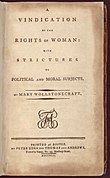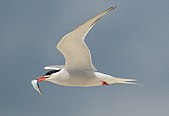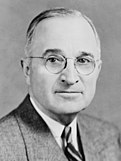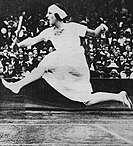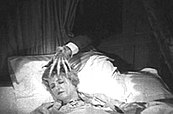Wikipedia:Today's featured article/July 2022
| << | Today's featured articles for July 2022 | >> | ||||
|---|---|---|---|---|---|---|
| Su | Mo | Tu | We | Th | Fr | Sa |
| 1 | 2 | |||||
| 3 | 4 | 5 | 6 | 7 | 8 | 9 |
| 10 | 11 | 12 | 13 | 14 | 15 | 16 |
| 17 | 18 | 19 | 20 | 21 | 22 | 23 |
| 24 | 25 | 26 | 27 | 28 | 29 | 30 |
| 31 | ||||||
July 1
SMS Kaiser Friedrich III was the lead ship of the Kaiser Friedrich III class of five pre-dreadnought battleships. Laid down in Wilhelmshaven in March 1895, the ship was launched in July 1896, entered service in October 1899, and became the flagship of I Squadron of the German Home Fleet in 1900. The battleship was armed with a main battery of four 24-centimeter (9.4 in) guns, supported by a secondary battery of eighteen 15 cm (5.9 in) guns. In 1901 the vessel was severely damaged striking submerged rocks; this led to design changes in later German battleships. Kaiser Friedrich III was extensively modernized in 1908 and placed in the Reserve Formation in 1910. Though obsolete, the aging battleship served as a coastal defence ship in the early months of World War I. The vessel was withdrawn from service by February 1915, and was later employed as a prison ship and a barracks ship, before being broken up in 1920. (This article is part of a featured topic: Battleships of Germany.)
July 2
A Vindication of the Rights of Woman is a 1792 book of feminist philosophy by Mary Wollstonecraft. Wollstonecraft argues that women ought to have an education commensurate with their position in society, claiming that women are essential to the nation because they educate its children and could be "companions" to their husbands. Instead of viewing women as ornaments or property, she maintains that they are human beings deserving of the same fundamental rights as men. Wollstonecraft was prompted to write the Rights of Woman by Charles-Maurice de Talleyrand-Périgord's 1791 report to the French National Assembly which stated that women should only receive a domestic education; she commented to launch a broad attack against sexual double standards and to indict men for encouraging women to be excessively emotional. She wrote the Rights of Woman hurriedly in order to respond quickly; she died before completing a more thoughtful second volume. (This article is part of a featured topic: Mary Wollstonecraft.)
July 3
The common tern (Sterna hirundo) is a seabird with four subspecies breeding in temperate and subarctic regions of Europe, Asia and North America. This tern is migratory, wintering in warmer coastal regions. Adults have light grey upperparts, whiter underparts, a black cap, orange-red legs, and a narrow pointed black-tipped red or all-black bill. The bird nests on any flat bare surface close to water, including rafts. The nest is a scrape lined with whatever is available. It lays up to three blotchy camouflaged eggs, incubated by both sexes, that hatch in around 21 to 22 days. The downy chicks fledge in 22 to 28 days. This tern feeds by plunge-diving for fish in the sea or freshwater. Eggs and young are vulnerable to predation by mammals and large birds. The common tern's large population and huge breeding range mean that it is classed as being of least concern. Despite international protection, in some areas populations are threatened by habitat loss or the disturbance of breeding colonies. (Full article...)
July 4
In 1948, Harry S. Truman contested the presidency of the United States. Truman (pictured), a Democrat, ascended to the presidency upon the death of Franklin D. Roosevelt. His pro–civil rights views were opposed by most of the Southern Democrats; when the Democratic National Convention adopted his civil rights plank, a large group of Southerners walked out. Truman selected Alben W. Barkley as his running mate. Campaigning against Thomas E. Dewey, the Republican candidate, Truman called the Republican-controlled 80th Congress a "do-nothing Congress". He conducted a whistle-stop tour giving speeches in different states. With the split of the Democratic Party, most of the polls predicted Truman to lose the election. On the election day, before the declaration of final results, an early edition of the Chicago Daily Tribune printed the headline "Dewey Defeats Truman", boldly anticipating Dewey's victory. Truman won the election in one of the greatest upset victories, receiving 303 electoral votes. (Full article...)
July 5
Hannah Montana is an American teen sitcom created by Michael Poryes, Rich Correll, and Barry O'Brien that aired on Disney Channel for four seasons between March 2006 and January 2011. The series centers on Miley Stewart (Miley Cyrus), a teenage girl living a double life as the famous pop singer Hannah Montana (pictured), an alter ego she adopted so she could maintain her anonymity and live a normal life as a typical teenager. The Walt Disney Company commissioned the series to continue its successful line of music-based franchises. Hannah Montana is one of Disney Channel's most commercially successful franchises; the program influenced the development of merchandise, soundtrack albums, and concert tours. It also helped launch Cyrus's musical career and established her as a teen idol. Hannah Montana was nominated for four Primetime Emmy Awards for Outstanding Children's Program from 2007 to 2010. However, television critics disliked the writing and depiction of gender roles and stereotypes. (Full article...)
July 6

The Jubilee coinage are British coins with an obverse depicting Queen Victoria (pictured) by Joseph Edgar Boehm, and were struck between 1887 and 1893. In 1879, Boehm was selected to create a new depiction of Victoria—some British coins still showed her as she had appeared forty years previously. Boehm was slow to complete the project, and it took years before it came to fruition. The new coins were released in June 1887, at the time of the queen's Golden Jubilee. The crown on Victoria's head was seen as too small, was widely mocked, and helped bring about the design's replacement. The series saw the entire issuance of the double florin, from 1887 to 1890, and the last circulating British fourpence piece, intended for use in British Guiana, in 1888. Bronze coins (the penny and its fractions) were not part of the Jubilee coinage, due to a surplus of them in commerce. The Jubilee coinage's replacement, the Old Head coinage, with an obverse created by Thomas Brock, began to be struck in 1893. (Full article...)
July 7

For timekeeping, Finland follows Eastern European Time (EET) during its winter as standard time and Eastern European Summer Time (EEST) in the summer as daylight saving time. EET is two hours ahead of Coordinated Universal Time and EEST is three hours ahead. Finland adopted EET in 1921, and daylight saving time in its current form from 1981. Up to the 19th century, each locality used its own solar time, which could vary in Finland by up to 31 minutes. In 1862, a mean time was adopted as a single time zone for railway scheduling. Daylight saving time was first attempted in 1942, abandoned as not useful, and introduced again in 1981 to align with neighbouring countries. In 2017, the Finnish parliament voted to call on the European Union to abolish daylight saving time. Finland's time zone is maintained by the VTT Technical Research Centre of Finland and the Centre for Metrology and Accreditation, using an atomic clock and hydrogen monitors. The 24-hour clock notation is used in Finland. (Full article...)
July 8
Christian Bale (born 1974) is an English actor. Known for his versatility and recurring physical transformations to play his roles, Bale has been a leading man in films of several genres. Born in Wales, he had his breakthrough role at age 13 in the war film Empire of the Sun (1987) and gained wider recognition for his work in the black comedy American Psycho (2000) and the psychological thriller The Machinist (2004). Bale played the superhero Batman in Batman Begins (2005) and reprised the role in the sequels The Dark Knight (2008) and The Dark Knight Rises (2012). He received acclaim for his performance in the trilogy, which is one of the highest-grossing film franchises. The recipient of various accolades, including an Academy Award and a Golden Globe Award for his portrayal of the boxer Dicky Eklund in the biographical film The Fighter (2010), Bale was listed on Forbes magazine's list of the highest-paid actors in 2014. (Full article...)
July 9
Suzanne Lenglen (1899–1938) was a French tennis player. One of the sport's biggest stars and the dominant women's tennis player right after World War I, Lenglen was the inaugural world No. 1 and a six-time Wimbledon singles champion. After the war, she only had one singles loss and was undefeated in doubles with Elizabeth Ryan. Her popularity stemmed from her becoming a world champion at age 15, her unusual balletic playing style, her brash personality, and prominent press coverage that portrayed her as infallible at tennis. Lenglen had a wide impact on the sport. She was the first leading amateur to turn professional and her 1926 pro tour in the United States laid the foundation for the next four decades of men's pro tennis. She incorporated fashion into the game and popularised sportswear to supplant the norm of women competing in corsets. Wimbledon moved to its current venue to accommodate her popularity. Court Suzanne Lenglen at the French Open is named in her honour. (Full article...)
July 10

A globular cluster is a spherical collection of stars that orbits a galaxy core as a satellite. They are tightly bound by gravity, which gives them their spherical shape and relatively high stellar density towards their core. There are more than 150 known globular clusters in the Milky Way, with perhaps many more undiscovered. Large galaxies can have more: Andromeda, for instance, may have as many as 500. Some giant elliptical galaxies, such as M87, may have as many as 10,000 globular clusters. These globular clusters orbit the galaxy out to large radii, 40,000 parsecs or more. Every galaxy of sufficient mass in the Local Group and almost every large galaxy surveyed has an associated system of globular clusters. The Sagittarius Dwarf Spheroidal Galaxy and Canis Major Dwarf Galaxy both appear to be in the process of donating their associated globular clusters to the Milky Way, such as Palomar 12. (Full article...)
July 11
The Midland Railway War Memorial is a First World War memorial in Derby, England, designed by Sir Edwin Lutyens. It commemorates employees of the Midland Railway who died while serving in the First World War. The Midland was the largest employer in Derby; around a third of the company's workforce left to fight and 2,833 were killed. The memorial consists of a cenotaph surrounded on three sides by a screen wall. Affixed to the wall are bronze plaques which list the names of the dead. The cenotaph is surmounted by a recumbent effigy of a soldier, covered by a coat and resting on a catafalque. Lutyens anonymises the soldier by lifting him high above eye level. The Midland published a book of remembrance, and sent a copy to the family of each man listed on the memorial. Unveiled on 15 December 1921, the memorial stands in a conservation area and is a Grade II* listed building. Repairs were undertaken in 2010 after several stolen bronze plaques were recovered. (Full article...)
July 12
Mount Melbourne is a 2,733-metre-high (8,967 ft) ice-covered stratovolcano in Victoria Land, Antarctica. It is an elongated mountain with a snow-filled summit caldera and numerous parasitic vents; a volcanic field surrounds the edifice. Mount Melbourne has a volume of about 180 cubic kilometres (43 cu mi) and last erupted between 1862 and 1922. Its volcanism is related both to the West Antarctic Rift and to local tectonic structures such as faults and grabens. Mount Melbourne has mainly erupted trachyandesite and trachyte, which formed within a magma chamber; basaltic rocks are less common. Geothermal heat flow on Mount Melbourne has created an unusual ecosystem formed by mosses and liverworts that grow between fumaroles, ice towers, and ice hummocks. This type of vegetation is found at other volcanoes of Antarctica and develops when volcanic heat generates meltwater from snow and ice, thus allowing plants to grow in the cold Antarctic environment. (Full article...)
July 13
Tyler Skaggs (July 13, 1991 – July 1, 2019) was an American left-handed starting pitcher in professional baseball. He played in Major League Baseball (MLB) for the Arizona Diamondbacks and Los Angeles Angels from 2012 until his death. Born in Woodland Hills, California, Skaggs was a supplemental first-round selection for the Angels in the 2009 MLB draft. Traded to the Diamondbacks in 2010, he made his MLB debut in 2012. Traded back to the Angels in December 2013, he was fifth in the team's rotation until an ulnar collateral ligament injury in 2014 and subsequent Tommy John surgery derailed his career. After a visiting game in 2019, Skaggs was found unresponsive in his hotel room in Southlake, Texas, and was pronounced dead the same day. An autopsy concluded that he had accidentally died of asphyxia after aspirating his own vomit while under the influence of fentanyl, oxycodone, and alcohol. His team wore patches with No. 45, his uniform number, for the rest of the season in his memory. (Full article...)
July 14
Year Zero is the fifth studio album by American industrial rock act Nine Inch Nails (pictured), released on April 17, 2007, by Interscope Records. Frontman Trent Reznor wrote the music and lyrics while touring for the group's previous release, With Teeth (2005). Contrasting Reznor's previously introverted style of songwriting, Year Zero is a concept album that criticizes contemporary policies of the U.S. government by presenting a dystopian vision of the year 2022. It is part of a project which includes a remix album and an alternate reality game (ARG). The Year Zero ARG expanded upon the album's fictional storyline by using media such as websites, pre-recorded phone messages, and murals. Year Zero received very positive reviews, many favorable toward the ARG. The album produced two singles, "Survivalism" and "Capital G", the latter released as a promotional single. Disputes arose between Reznor and Universal Music Group, parent company of Interscope, over the overseas pricing of the album. (Full article...)
July 15
Pennatomys nivalis is an extinct oryzomyine rodent from the islands of Sint Eustatius, Saint Kitts, and Nevis in the Lesser Antilles (range pictured). It is known from skeletal remains found in Amerindian archeological sites on all three islands, with dates ranging from 790–520 BCE to 900–1200 CE. No live specimens are known, but there are several historical records of rodents from Saint Kitts and Nevis that could conceivably refer to Pennatomys. The animal apparently belongs to a group within the tribe Oryzomyini that includes many other island-dwelling species. Pennatomys nivalis was a medium-sized species without many distinctive adaptations. The nasal bones were short and blunt-ended. The zygomatic plate, a bony plate at the side of the skull, was broad. The bony palate was long and flat. The root of the lower incisor was housed in a bony protuberance, the capsular process. The molars were low-crowned and possessed accessory crests such as mesolophs. The upper molars all had three roots. (Full article...)
July 16
The Danzig Street shooting occurred on the evening of 16 July 2012 during a crowded block party at Morningside Coronation (pictured), a social-housing complex in Toronto, Ontario, Canada. Threats and confrontations between members of rival gangs escalated into the city's worst mass shooting, a gunfight which killed two and injured twenty-four others. Those convicted in relation to the shooting were teenagers during the fight. The Ontario provincial government enacted social programs aimed at curbing youth violence, while Rob Ford, Mayor of Toronto, called for the shooters to be expelled from the city. Jason Kenney, the immigration minister, cited the shooting in debate of the Faster Removal of Foreign Criminals Act which came into effect in 2013. The Toronto Police Service developed new crime-prevention strategies, producing intelligence about crime in the city. This allowed a targeted crackdown on the Galloway Boys gang and other gang activity in the city, and a dramatic reduction in shootings and other crimes. (Full article...)
July 17
Paper Mario: Color Splash is a 2016 video game developed by Intelligent Systems and published by Nintendo for the Wii U console. It is the fifth game in the Paper Mario series. The story follows Mario and a paint bucket named Huey as they work to save Prisma Island and rescue Princess Peach from Bowser. The game world is made up of crafting materials. Along the way, Mario and Huey encounter places that lack color, and Mario must fill them in with his paint hammer. The developers focused on color-themed puzzles and comedy, and implemented card-based combat to use the gamepad's touchscreen to sort, paint, and flick cards. Color Splash was initially criticized for its focus on turn-based action-adventure elements, continuing the trend started by its predecessor to move the series away from its role-playing game roots. However, it received generally positive reviews upon release, gaining praise for its writing, graphics, and gameplay elements. (Full article...)
July 18
Khalid ibn al-Walid (died 642) was a commander under the Islamic prophet Muhammad and the first two caliphs, Abu Bakr and Umar. Before his conversion to Islam, Khalid helped defeat the Muslims at the Battle of Uhud in 625. After Khalid converted, Muhammad bestowed on him the title Sayf Allah ('the Sword of God'). In 632, Khalid was appointed by Abu Bakr to suppress or subjugate the tribes of central Arabia opposed to the nascent Muslim state in the Ridda wars. He led the initial campaigns in Sasanian Iraq in 633–634, before being deployed to lead the Muslim conquest of Byzantine Syria. He reached Syria after a famed desert march and led the decisive Muslim victory over the Byzantines at the Battle of Yarmouk. Umar demoted Khalid around 636, but he continued military service in Syria for about two more years. Though the Islamic tradition lauds his command of the early conquests, Khalid's military fame disturbed some early Muslims, including Umar, who feared it could develop into a personality cult. (Full article...)
July 19
The Battle of Halidon Hill took place on 19 July 1333 when a Scottish army under Sir Archibald Douglas attacked an English army commanded by King Edward III (reigned 1327 to 1377) and was heavily defeated. In early 1333 Edward invaded Scotland and laid siege to the strategically important border town of Berwick-upon-Tweed. A large Scottish army advanced to relieve the town. Knowing Berwick was on the verge of surrender and aware they were much stronger than the English, the Scots attacked (depicted). The English had taken up a favourable defensive position and their longbowmen caused heavy Scottish casualties during their approach. When the Scots came into contact with the English infantry the fight was short. The Scottish formations collapsed and the Scots fled. The English men-at-arms mounted their horses and pursued the Scots for 8 miles (13 km) causing further heavy casualties. The Scottish commander and many of the Scots' senior nobility were killed. Berwick surrendered on terms the next day. (Full article...)
July 20
Maurice Leyland (20 July 1900 – 1 January 1967) was an English international cricketer, a left-handed batsman. He played 41 Test matches between 1928 and 1938 and was a Wisden Cricketer of the Year in 1929. In first-class cricket, he represented Yorkshire between 1920 and 1946, scoring over 1,000 runs in 17 consecutive seasons. He made his Test début in 1928 against the West Indies, and was a member of the English team that toured Australia that winter, scoring a century in his only Test of the series. He held his place most of the time until 1938 when he was replaced for the series against Australia. Recalled to play in the final match, he scored 187, his personal best Test score, in his last ever Test match. Leyland had a reputation for batting well under pressure. He performed most effectively against the best teams and bowlers; his Test batting record is better than his first-class figures, and against Australia his average is even higher. Leyland had a reputation as a humorist, with many stories told about him. (Full article...)
July 21
The Cat and the Canary is a 1927 American silent horror film directed by German Expressionist filmmaker Paul Leni. An adaptation of John Willard's 1922 black-comedy play of the same name, the film stars Laura La Plante, Forrest Stanley and Creighton Hale. The plot revolves around the death of a man, and the reading of his will 20 years later. A woman inherits her uncle's fortune, but when she and her family spend the night in his mansion they are stalked by a mysterious figure (scene pictured). They have also been told that a lunatic has escaped from an asylum and is hiding in the mansion. The film is part of the genre of comedy horror films inspired by 1920s Broadway plays. The Cat and the Canary blends expressionism with humor, a style for which Leni was notable. It was influential in the "old dark house" genre of films popular from the 1930s through the 1950s. The film was one of Universal's early horror productions, and is considered to be the "cornerstone of Universal's school of horror". (Full article...)
July 22
The Anglo-Scottish War was the final conflict in the British Wars of the Three Kingdoms. When the Royalists were defeated in 1648, after the First and Second English Civil Wars, the English government ordered the execution of their king, Charles I, who was also, separately, the king of Scotland, then an independent nation. The Parliament of Scotland declared his son, Charles II (depicted), to be King of Britain. Seeing this as a threat, an English army under Oliver Cromwell invaded Scotland on 22 July 1650. After a month of manoeuvring Cromwell heavily defeated the Scots at Dunbar. In July 1651 the English crossed the Firth of Forth and defeated the Scots at Inverkeithing, cutting their army off from supply and reinforcements. In desperation Charles II invaded England in August. Cromwell pursued, brought the badly outnumbered Scots to battle on 3 September 1651 and completely defeated them, ending the Wars of the Three Kingdoms and resulting in Scotland's absorption into the English Commonwealth. (Full article...)
July 23
"No" is a song by American singer-songwriter Meghan Trainor from her second major-label studio album Thank You (2016). Ricky Reed (pictured) produced the song and wrote it with Trainor and Jacob Kasher Hindlin; Epic Records released it as the album's lead single on March 4, 2016. A dance-pop song inspired by 1990s music and R&B, "No" has lyrics about sexual consent and women's empowerment which encourage them to reject unwanted advances from men. Critics praised "No" as a showcase of her confident and mature side, and an improvement from the lyrics on her earlier songs. Charting in the top 10 in various countries, including at number 3 in the U.S., it earned multi-platinum certifications in Australia, Canada, and Poland. Critics compared its music video, which features Trainor dancing in a warehouse, to those of 1990s female artists and praised her evolution. She performed "No" on her 2016 concert tour and television shows such as the iHeartRadio Music Awards and The Ellen DeGeneres Show. (Full article...)
July 24
John Tyndall (1934–2005) was a British fascist and political activist. A member of various small neo-Nazi groups during the late 1950s and 1960s, he led the National Front from 1972 to 1974 and again from 1976 to 1980, and then headed the British National Party from 1982 to 1999. He unsuccessfully stood for election to the House of Commons several times and to the European Parliament in 1999. Tyndall promoted a racial-nationalist belief in a distinct white "British race", arguing that this race was threatened by a Jewish conspiracy to encourage non-white migration into Britain. He called for an authoritarian state which would deport all non-whites from the country, engage in a eugenics project, and re-establish the British Empire through the military conquest of parts of Africa. He never gained mainstream political respectability in the United Kingdom but was popular among sectors of the British far-right. In 2005, Tyndall was charged with incitement to racial hatred but died before trial. (Full article...)
July 25

Edward the Elder (c. 874 – 924) was King of the Anglo-Saxons from 899 until his death. He was the elder son of Alfred the Great and his wife Ealhswith. When Edward succeeded to the throne, the Vikings ruled Northumbria, East Anglia and eastern Mercia, leaving only Wessex and western Mercia under Anglo-Saxon control. In 910 a Mercian and West Saxon army inflicted a decisive defeat on an invading Northumbrian army, ending the threat from the northern Vikings. In the 910s, Edward conquered Viking-ruled southern England in partnership with his sister Æthelflæd, who ruled Mercia. By 919 he ruled Wessex, Mercia and East Anglia, and only Northumbria remained under Viking rule. Edward was admired by medieval chroniclers, but he was largely ignored by modern historians until the 1990s, partly because few primary sources for his reign survive. He is now seen as destroying the power of the Vikings in southern England while laying the foundations for a south-centred united English kingdom. (Full article...)
July 26
Barkhale Camp is a causewayed enclosure, a Neolithic archaeological site on Bignor Hill, on the South Downs of West Sussex, England. English causewayed enclosures, built from around 3700 BC until at least 3500 BC, are enclosed with ditches interrupted by gaps, or causeways. They may have been settlements, meeting places, or ritual sites. Barkhale Camp was identified by John Ryle in 1929 and surveyed the following year by E. Cecil Curwen, who listed it as a possible Neolithic site. A small trench was dug in 1930 by Ryle, and more extensive excavation was undertaken by Veronica Seton-Williams between 1958 and 1961, which found a characteristically Neolithic assemblage of flints. Peter Leach conducted another excavation in 1978, examining several mounds and attempting to find the line of the ditch and bank along the southern boundary. No material suitable for radiocarbon dating was recovered, but Leach suggested that the site was constructed in the earlier Neolithic, between 4000 BC and 3300 BC. (Full article...)
July 27
The human history of Chincoteague, an island on the Eastern Shore of Virginia, begins with Native Americans gathering shellfish there. By one popular legend, the name meant "Beautiful land across the water" in their language. The feral population of Chincoteague ponies likely originated from European settlers using the island in the 17th century to graze livestock. Seafood resources were systematically exploited in the early 19th century, and oysters became a major industry after the Civil War. Chincoteague's relative isolation ended in 1876 when the railroad arrived at Franklin City, across Chincoteague Bay, and a steamboat service was introduced; a road causeway was completed in 1922. The Chincoteague Fire Department was established in 1925 and took over the traditional pony penning to raise funds. The 1947 book Misty of Chincoteague and its 1961 film helped publicize the island. The annual carnival, pony swim (pictured) and subsequent auction now attract tens of thousands of visitors. (Full article...)
July 28
Thalassodromeus was a pterosaur (a flying reptile) that lived in what is now northeastern Brazil about 100 million years ago, during the Early Cretaceous. The original skull was discovered in 1983 in the Romualdo Formation of the Araripe Basin. This genus had one of the largest known skulls among pterosaurs, around 1.42 metres (4 ft 8 in) long, with one of the largest cranial crests of any vertebrate in proportion to its skull. Running from the tip of the upper jaw to beyond the occiput at the back of the skull, the lightly built crest may have been used for thermoregulation or in display behaviour. The crest may not have fully developed until after sexual maturity. Though only the skull is known, the animal is estimated to have had a wingspan of 4.2 to 4.5 m (14 to 15 ft). The jaws were toothless, with sharp upper and lower edges and strong musculature. Thalassodromeus may have been able to kill and eat prey on the ground. (Full article...)
July 29

Apollo 4 was the first flight in the Apollo program and served as an initial uncrewed test of the Saturn V rocket. The first launch from Kennedy Space Center, Florida, where the space vehicle was assembled, it was originally planned to take place early in 1967 but was delayed to November 9 due to a myriad of issues. These included the need for additional inspections following the Apollo 1 fire that killed the first Apollo crew in January 1967. Apollo 4 was an "all-up" test, meaning that the spacecraft was fully functional on its initial flight, the first such for NASA. The Apollo 4 command module splashed down just under nine hours after its launch, having completed all objectives. NASA deemed the mission a complete success as it proved that the Saturn V rocket worked, which was important in achieving NASA's overall goal of landing astronauts on the Moon and bringing them back safely by the end of the 1960s. (Full article...)
July 30
Marvel Tales and Unusual Stories were two U.S. semi-professional science fiction magazines published by William L. Crawford, a science fiction fan who believed that the pulp magazines were too limited in what they would publish. In 1933, he distributed a flyer for Unusual Stories (cover pictured), stating that no taboos would prevent the publication of worthwhile fiction. It included a page from P. Schuyler Miller's "The Titan", unsellable to professional magazines because of its sexual content. A partial issue of Unusual Stories was distributed in early 1934, and Crawford launched Marvel Tales in May 1934. Five issues of Marvel Tales and three of Unusual Stories appeared over two years. They included Robert E. Howard's "The Garden of Fear", H. P. Lovecraft's "Celephaïs", and Clifford D. Simak's "The Creator"; the last had previously been rejected because of its religious theme. By 1936, Crawford had plans to expand his enterprise, but limited finances meant that no further issues appeared. (Full article...)
July 31
The red-headed myzomela (Myzomela erythrocephala) is a bird of the honeyeater family, Meliphagidae. One of two subspecies, M. e. erythrocephala, is distributed around the tropical coastline of Australia; the other, M. e. infuscata, is found mainly around the southern coastline of New Guinea. The species was described by John Gould in 1840. Though widely distributed and not threatened, the species is not abundant within its range. At 12 centimetres (4.7 in), the red-headed myzomela is a small honeyeater with a short tail and relatively long down-curved bill. It is sexually dimorphic; the male has a glossy red head, brown upperparts and paler grey-brown underparts, while the female has predominantly grey-brown plumage. Little has been documented on its breeding behaviour. The bird's natural habitat is tropical mangrove forests. It is very active when feeding in the tree canopy, darting from flower to flower and gleaning insects off foliage. It calls constantly as it feeds. (Full article...)


